|
Our second climb of the weekend, the day after Sisyphus, we headed up Prime Rib with the option of bailing if we were tired being strong in the back of our mind. However, this route was fairly easy and relaxing for the most part (falling rock on pitch 8 kind of woke me up from the relaxing times, along with strong wind gusts on pitch 11). Prime Rib strolls up fairly easy ground on mostly highly positive holds. This is a great multi-pitch climb for a 5.8 climber, however for those that don't like climbing above bolts, the easy first pitch may scare you a bit, but this is only temporary. I did find it unusual that a climb of this grade and semi-relaxing nature would skimp on the bolts on the 5.3 section, yet Sisyphus was well protected on 5.5 climbing. With that said, I found this route much more dangerous than Sisyphus, not for the lack of bolts, but for the rock fall potential due to heavier traffic and the way the rappel route lined up with the climbing route.
Description:
From Mazama, drive 3.0 miles from the Mazama store and park at a pullout on the left. You should be able to see the river from the pullout, and there is a trail to it. Head down the road away from the Mazama store about 100 yds and find a logging road. Follow that past an interesting concrete structure and good bivy sites to a single track trail. Follow this along the talus field or hop on the talus field for easier going, staying near the left side. Though the approach isn't very far, we brought our treking poles (as my cousin would say: "wussy sticks") for the way down, learning from our trip up Sisyphus.
Rejoin the trail near the top of the talus and follow it to the starting gully, where you can gear up.
The topo of the route is useful, especially for rappelling and can be found below: 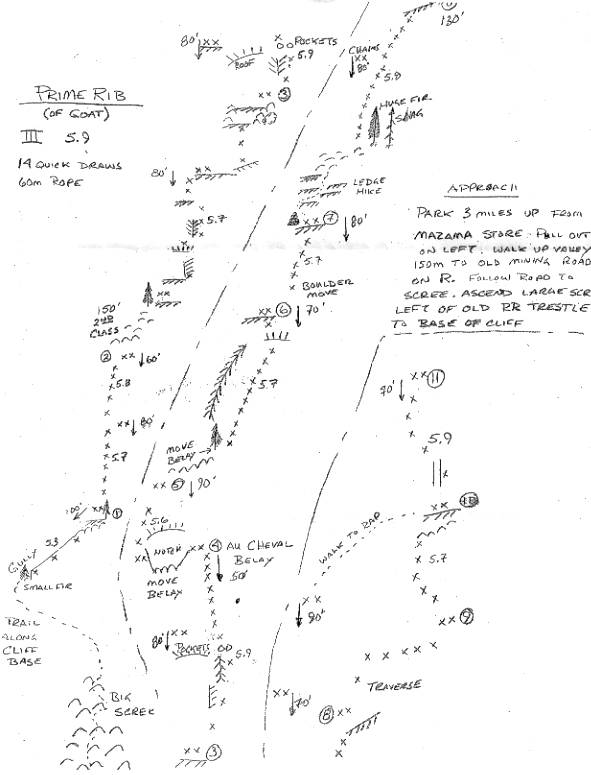 This climb is fully bolted, so leave your pro in the car.
- 5.3, 115ft. Climb the 5.3 step-up on the run-out first pitch. There is very little chance of a fall here due to the easy nature of the climbing, but a fall may be a ground fall in many places on this pitch.

Starting gully and Pitch 1 and 2
- 5.8. 100ft. Climb easy, juggy 5.7 near-vertical rock that gradually gets harder near the top where you will encounter a 5.8 move on good holds but tricky feet. The anchors are directly at the top. Move anchors with an easy class 2 walk up hill. Look to the right of the large tree for the anchor.
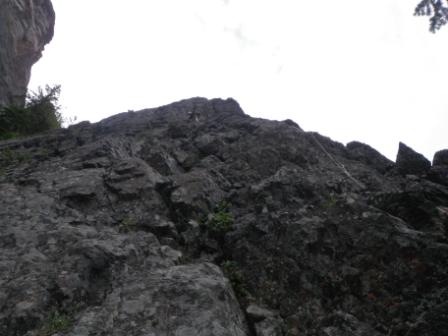
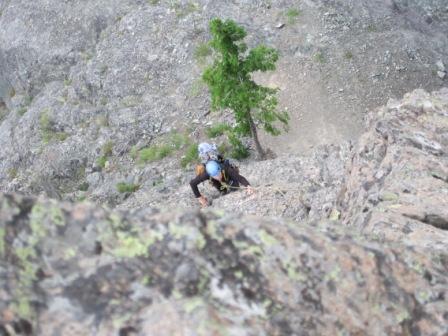
Pitch 2
- 5.7 120ft.?? Climb the 5.7 semi-steep dihedral with large positive holds until you can scramble up easy ledges with loose rock. An anchor can be found up and right.
- 5.9 100ft.?? Climb the 5.9 section, where a slightly tricky sequence of pockets show up after climbing above a roof. The anchor is at a peak in the rock where you can belay on either side or au-cheval style. Have your partner move the anchor 25 ft to the other side of the notch.
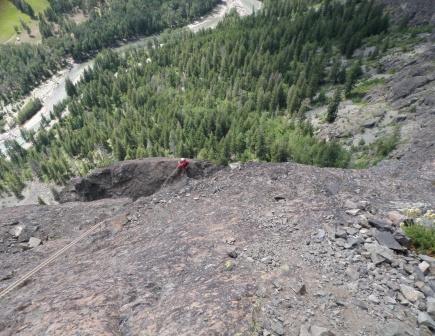
Pitch 4 from above
- 5.6 80ft. Climb the easy short pitch and move belays to a large tree. The tree can be slung if necessary for a belay.
- 5.7 80ft. This pitch traverses right, maintaining a cool line and position at the top edge of a drop-off. The last move is somewhat steep with good holds.
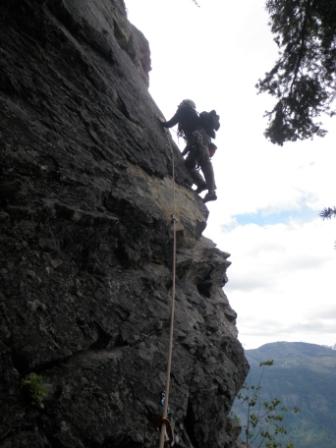
Enjoying the position on pitch 6
- 5.7 80ft. The bottom boulder move is much easier than it initially appears, though it may be difficult for shorter climbers. At the top of this pitch, scramble up 3rd class ledges, taking note of the direction you ascent since you will have to retrace your steps on the descent. Be careful with this section on the descent.
- 5.8 130ft. Climb the slightly slabby section, where it makes a bowing arch toward the left before heading right to the anchors. WARNING: this and the next pitch may be the areas of highly rock fall potential, most likely from rappellers or climbers from above. The leftward bow leads directly below 3 rappel anchors that if rock falls, may hit you on this pitch (my partner had this experience). The anchor is safer, but not completely devoid of danger. The start is in line with rock fall from pitch 9 and especially pitch 10, where many rocks are encountered.
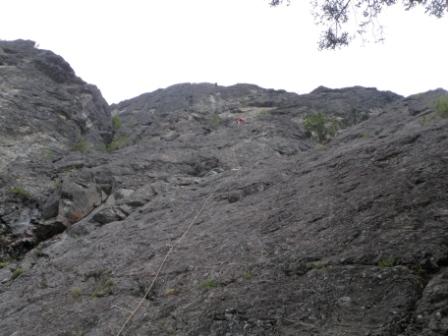
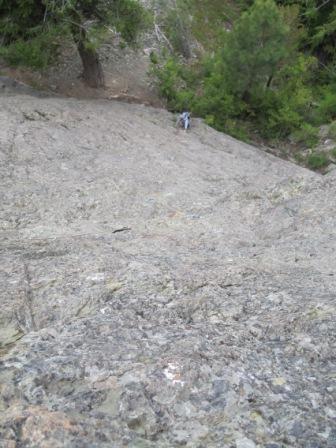
Pitch 8
- 5.5 60ft. Traverse the airy, but straight-forward sloping ledge that puts you in a cool position with nice exposure.
- 5.3 50ft. Climb the easy, highly contrived slab pitch that places you in the most exposure possible (I wish the route went directly to the bottom of the 11th pitch instead of following this line since it didn't seem to add anything to the route, but I would not suggest anybody do that with the liklihood of causing rockfall onto other parties below). At the anchors, head over to the bottom of pitch 11 (one bolt for anchor), being careful to not send any rocks down on climbers below.

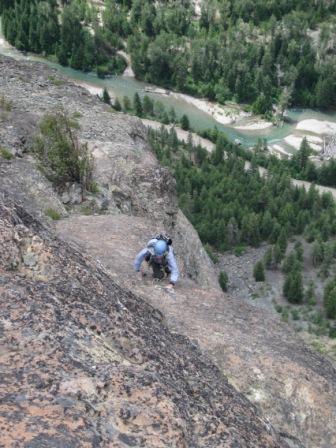
Pitch 9 Pitch 10
- 5.9 70ft. Climb the slab and head into the steep chimney with good holds and exit left, making your way up the steep roof. I experienced extreme rope drag on this pitch, so plan out your draws if you can see where the pitch goes, which is hard to do from the climb on this pitch. This is probably the crux of the climb, especially if you have 35mph wind gusts.
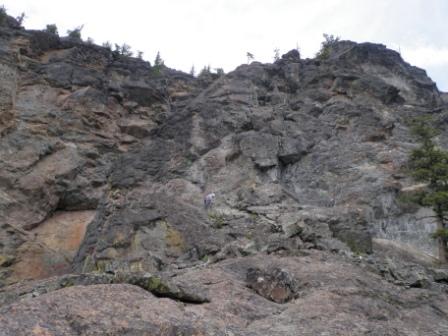
Another party on pitch 11 The descent consists of 14 single-rope rappels or with downclimbing/scrambling on the ledge systems. Be particularly cautious of knocking rocks down during the 3 rappels from the top of pitch 10 to the bottom of pitch 8 (rappels 2-4).
I found this climb to be well protected (aside from pitch 1) on sometimes steep rock with very positive holds and great friction. It's amazing how different this route is from its sister route: Sisyphus. However I feel that this route is more dangerous than Sisyphus if you are sharing it with other climbers, especially on the noted spots above. If you are not sharing it with other climbers, this route is fairly safe.
I highly enjoyed pitches 2, 4, 6, 9, and 11 of this route, so if you like juggy, semi-steep climbing that is easy, aim to get these pitches.
Gear: bring a 60 m rope, helmets, and 14ish draws (give or take), belay jacket or at least wind-breaker (there was little to no breeze at the car, but the wind was howling at the top of pitch 9-11)
|

|











